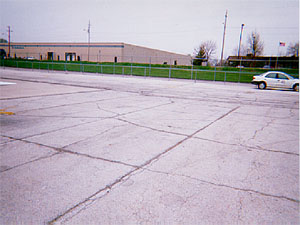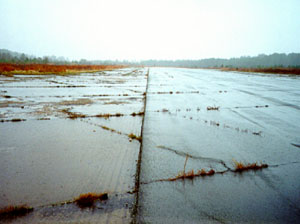Joint Reflection Cracking
This distress occurs only on pavements having an asphalt or tar surface over a portland cement concrete (PCC) slab. This category does not include reflection cracking from any other type of base (that is, cement stabilized, lime stabilized). Such cracks are listed as longitudinal and transverse cracks. Joint reflection cracking is caused mainly by movement of the PCC slab beneath the asphalt concrete (AC) surface because of thermal and moisture changes; it is not load-related. However, traffic loading may cause a breakdown of the AC near the crack, resulting in spalling and foreign object damage potential (FOD). If the pavement is fragmented along a crack, the crack is said to be spalled. A knowledge of slab dimensions beneath the AC surface will help to identify these cracks.
| Severity | Distress Example | Description |
| Low |  | Cracks have only light spalling (little or no FOD potential) or no spalling, and can be filled or nonfilled. If nonfilled, the cracks have a mean width of 1/4 in (6 mm) or less; filled cracks are of any width, but their filler material is in satisfactory condition. |
| Medium |  | One of the following conditions exists: cracks are moderately spalled (some FOD potential) and can be either filled or nonfilled of any width; filled cracks are not spalled or are lightly spalled, but filler is in unsatisfactory condition; nonfilled cracks are not spalled or are only lightly spalled, but the mean crack width is greater than 1/4 in (6 mm); or light random cracking exists near the crack or at the corners of intersecting cracks. |
| High |  | Cracks are severely spalled with pieces loose or missing causing definite FOD potential. Cracks can be either filled or nonfilled of any width. |